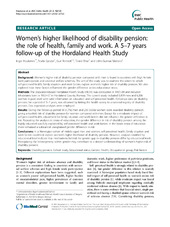| dc.contributor.author | Haukenes, Inger | en_US |
| dc.contributor.author | Gjesdal, Sturla | en_US |
| dc.contributor.author | Rørtveit, Guri | en_US |
| dc.contributor.author | Riise, Trond | en_US |
| dc.contributor.author | Mæland, John Gunnar | en_US |
| dc.date.accessioned | 2013-05-16T10:38:55Z | |
| dc.date.available | 2013-05-16T10:38:55Z | |
| dc.date.issued | 2012-08-31 | eng |
| dc.Published | BMC Public Health 2012, 12:720 | eng |
| dc.identifier.issn | 1471-2458 | |
| dc.identifier.uri | https://hdl.handle.net/1956/6620 | |
| dc.description.abstract | Background: Women’s higher risk of disability pension compared with men is found in countries with high female work participation and universal welfare schemes. The aim of the study was to examine the extent to which self-perceived health, family situation and work factors explain women’s higher risk of disability pension. We also explored how these factors influenced the gender difference across educational strata. Methods: The population-based Hordaland Health Study (HUSK) was conducted in 1997–99 and included inhabitants born in 1953–57 in Hordaland County, Norway. The current study included 5,959 men and 6,306 women in paid work with valid information on education and self-perceived health. Follow-up data on disability pension, for a period of 5–7 years, was obtained by linking the health survey to a national registry of disability pension. Cox regression analyses were employed. Results: During the follow-up period 99 (1.7%) men and 230 (3.6%) women were awarded disability pension, giving a twofold risk of disability pension for women compared with men. Except for a moderate impact of self-perceived health, adjustment for family situation and work factors did not influence the gender difference in risk. Repeating the analyses in strata of education, the gender difference in risk of disability pension among the highly educated was fully explained by self-perceived health and work factors. In the lower strata of education there remained a substantial unexplained gender difference in risk. Conclusions: In a Norwegian cohort of middle-aged men and women, self-perceived health, family situation and work factors could not explain women’s higher likelihood of disability pension. However, analyses stratified by educational level indicate that mechanisms behind the gender gap in disability pension differ by educational levels. Recognizing the heterogeneity within gender may contribute to a deeper understanding of women’s higher risk of disability pension. | en_US |
| dc.language.iso | eng | eng |
| dc.publisher | BioMed Central | eng |
| dc.rights | Attribution CC BY | eng |
| dc.rights.uri | http://creativecommons.org/licenses/by/2.0 | eng |
| dc.title | Women’s higher likelihood of disability pension: the role of health, family and work. A 5–7 years follow-up of the Hordaland Health Study | en_US |
| dc.type | Peer reviewed | |
| dc.type | Journal article | |
| dc.description.version | publishedVersion | en_US |
| dc.rights.holder | Copyright 2012 Haukenes et al.; licensee BioMed Central Ltd. | |
| dc.identifier.doi | https://doi.org/10.1186/1471-2458-12-720 | |
| dc.identifier.cristin | 985257 | |
| dc.source.journal | BMC Public Health | |
| dc.source.40 | 12 | |

